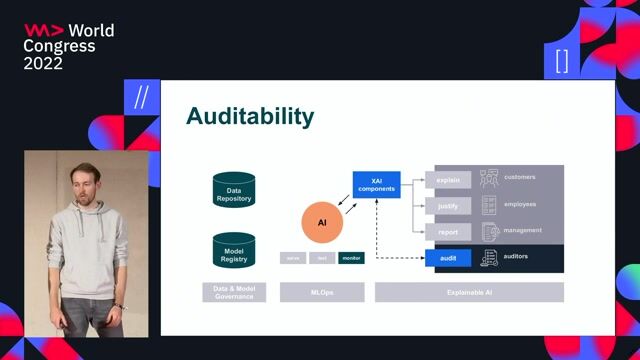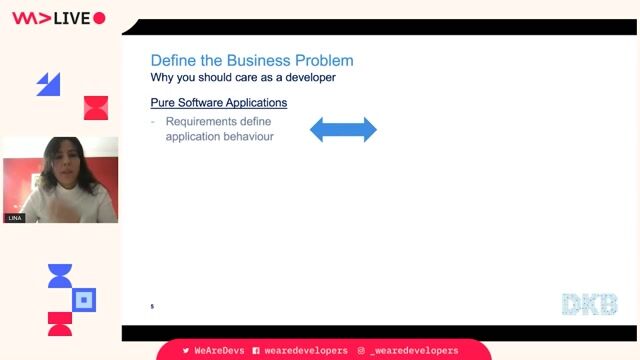Stefan Donsa & Lukas Alber
Detecting Money Laundering with AI
#1about 5 minutes
The lifecycle for operationalizing AI models in business
Moving beyond local development requires a structured lifecycle including ideation, proof of value, scaling, and continuous monitoring.
#2about 3 minutes
Understanding the limitations of rule-based AML systems
Traditional rule-based approaches for anti-money laundering suffer from high false-positive rates and fail to capture complex laundering patterns.
#3about 2 minutes
How AI improves AML and the challenges involved
AI can lower false positives and identify new threats, but success requires involving business experts and using explainable AI to build trust.
#4about 4 minutes
Using machine learning to detect KYC inconsistencies
Machine learning models analyze peer group behavior to identify outliers, such as a jobless person with high cash transactions, which rule-based systems miss.
#5about 5 minutes
A four-step process for unsupervised outlier detection
The process involves selecting relevant features, creating a master data table, using dimensionality reduction to find outliers, and scoring customers by reconstruction error.
#6about 3 minutes
Comparing PCA and autoencoders for anomaly detection
Principal Component Analysis (PCA) uses linear transformations while autoencoders use non-linear transformations for dimensionality reduction and reconstruction.
#7about 2 minutes
Validating the model's effectiveness with real-world results
The unsupervised models successfully identified over 100 suspicious cases, with one-third being new discoveries not caught by the existing rule-based engine.
#8about 3 minutes
The production architecture and technology stack for AML AI
The end-to-end system uses Hadoop for the data mart, PySpark for transformation, and Python with scikit-learn and MLflow for model development.
#9about 1 minute
Key takeaways for implementing AI in financial compliance
AI enhances AML efforts by detecting novel patterns, focusing agents on high-risk alerts, and providing transparent results to build trust with regulators.
Related jobs
Jobs that call for the skills explored in this talk.
Matching moments

10:13 MIN
Implementing a two-step fraud detection solution
Unleashing the power of AI to prevent financial crime

00:21 MIN
Using AI to combat financial crime at ING
Unleashing the power of AI to prevent financial crime

03:39 MIN
Applying supervised machine learning to pipeline data
Data Science, ML & AI in the Oil and Gas Industry at NDT Global - Dr. Katja Träumner

1:38:39 MIN
Demonstrating an AI-powered cash collection application
Intelligent Automation using Machine Learning

37:57 MIN
Q&A on AI adoption, tools, and challenges
Navigating the AI Wave in DevOps

15:52 MIN
Showcasing real-time AI application examples
Convert batch code into streaming with Python

12:45 MIN
Applying AI and database technology in FinTech
OpenAI for FinTech: Building a Stock Market Advisor Chatbot

25:48 MIN
Auditing AI systems using MLOps and explainability
Model Governance and Explainable AI as tools for legal compliance and risk management
Featured Partners
Related Videos
 29:40
29:40Unleashing the power of AI to prevent financial crime
 22:06
22:06Anomaly Detection - Using unsupervised Machine Learning for detecting anomalies in customer base
Lukas Kölbl
 48:07
48:07Is my AI alive but brain-dead? How monitoring can tell you if your machine learning stack is still performing
Lina Weichbrodt
 2:11:02
2:11:02Intelligent Automation using Machine Learning
Boris Krumrey & Andreas Palfi & Radu Pruna
 57:46
57:46Overview of Machine Learning in Python
Adrian Schmitt
 34:21
34:21DevOps for AI: running LLMs in production with Kubernetes and KubeFlow
Aarno Aukia
 56:46
56:46Explainable machine learning explained
Karol Przystalski
 23:50
23:50Data Privacy in LLMs: Challenges and Best Practices
Aditi Godbole
Related Articles
View all articles



From learning to earning
Jobs that call for the skills explored in this talk.

Lead Fullstack Engineer AI
Hubert Burda Media
München, Germany
€80-95K
Intermediate
React
Python
Vue.js
Langchain
+1


(Senior) Data & AI Consultant / Banking (all genders)
msg
Ismaning, Germany
Intermediate
Senior
Data analysis
Cloud (AWS/Google/Azure)

AI Engineer - Machine Learning LLM
Client Server
Humanes de Madrid, Spain
€130K
C++
Java
Python
Machine Learning
+1

Machine Learning Engineer
Lloyds Banking Group
Chester, United Kingdom
€57K
NumPy
Python
Pandas
Google BigQuery
+2

Data Engineer/ Data Scientist -AI/ML (LLM, Agentic AI, Python)
KBC Technologies UK LTD
Bournemouth, United Kingdom
Senior
NLTK
NumPy
Scrum
React
Python
+5

Machine Learning Engineer - AI-Features, Agenten & Multi Agenten Workflows
Deutsches Medizinrechenzentrum GmbH
Düsseldorf, Germany
Remote
API
.NET
DevOps
Python
+3

Machine Learning Engineer - AI Core
solera
Municipality of Madrid, Spain
API
Python
Docker
PyTorch
Grafana
+7

Machine Learning Scientist, Financial Crime
Monzo
Cardiff, United Kingdom
Remote
Senior
Python
A/B testing
Microservices
Machine Learning